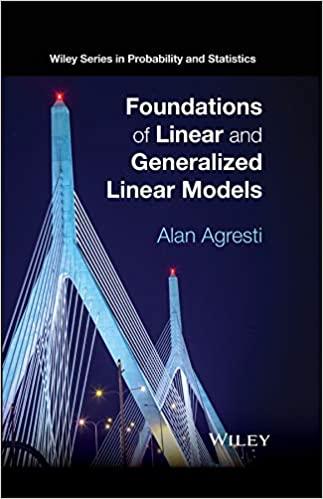A field study11 analyzed associations between a food web response measure and plant invasion and tidal restriction
Question:
A field study11 analyzed associations between a food web response measure and plant invasion and tidal restriction in salt marsh habitats. The response, observed in a species of small marsh fish (Fundulus heteroclitus) that swim in and out of the salt marshes with the tides, was a stable carbon isotope measure12 (????13C). It is used as a tracer in food studies because its uptake by plants and animals follows predictable patterns, and so it quantifies the carbon basis in a diet. A salt marsh is called “tidally restricted” if the tidal flow is restricted because of factors such as roads and dikes built across the marsh for residential developments. Such marshes tend to be invaded by non-native vegetation. A salt marsh is called “tidally restored” if it had been tidally restricted but is now in a restored state, with less non-native vegetation.
It is called a “reference” marsh if it had never been restricted. The study analyzed the extent to which a particular invasive plant (Phragmites australis)
contributes carbon to the food web in restricted marshes, relative to reference marshes, and how that changes as the cover of the native plants increases during restoration. The study’s experimental design used four tidally restored and four tidally restricted marshes and eight control marshes downstream from them. This resulted in 16 marshes and four marsh types: 1 = tidally restricted marsh, 2 = tidally restored marsh, 3 = control marsh near a tidally restricted marsh, 4 = control marsh near a tidally restored marsh. Half the marshes of each type were in each of two locations—Long Island Sound and the Gulf of Maine. Each marsh used three fixed locations for stations. These 16 marshes with 48 stations were visited in summer and fall of 2010 and 2011.
The researchers collected 10 fish at each station on every sample date and used the composited sample to measure the response variable. The data file has the form shown in Table 9.7.
a. For the stable carbon isotope response (variable d13C in the data file) at time t for station i, consider the model yit = ????0 + ????1xit1 + ????2xit2 + ⋯ + ????8xit8 + ui + ????it, where (xit1, xit2, xit3) are indicators for 3 of the 4 marsh types, xit4 is an indicator for the region, (xit5, xit6, xit7) are indicators for 3 of the 4 time periods, and xit8 is the mean length (in mm) from the 10 fish samples for that observation. For this model and application, specify the components and their dimensions in the model expression yi = Xi???? + Ziui + ????i.
b. Fit the model, assuming var(????i) = ????2 ???? I. Interpret results.
c. Conditional on a random-effect value ui, the authors expected observations at the same location to be correlated because of ecological processes, but less so with increasing time between them. So they used an autoregressive correlation structure in var(????i). Fit this model, analyze whether the fit is much better than assuming var(????i) = ????2 ???? I.
d. Because the data variability itself varies substantially between summer and fall and from year to year, the authors also permitted heterogeneous variances. Show that cov(yij, yik) = ????2 u + ????????(j)????????(k)????|j−k|
.
(The researchers also fitted more-complex models with interactions among treatment, region, and time.)
Step by Step Answer:

Foundations Of Linear And Generalized Linear Models
ISBN: 9781118730034
1st Edition
Authors: Alan Agresti





